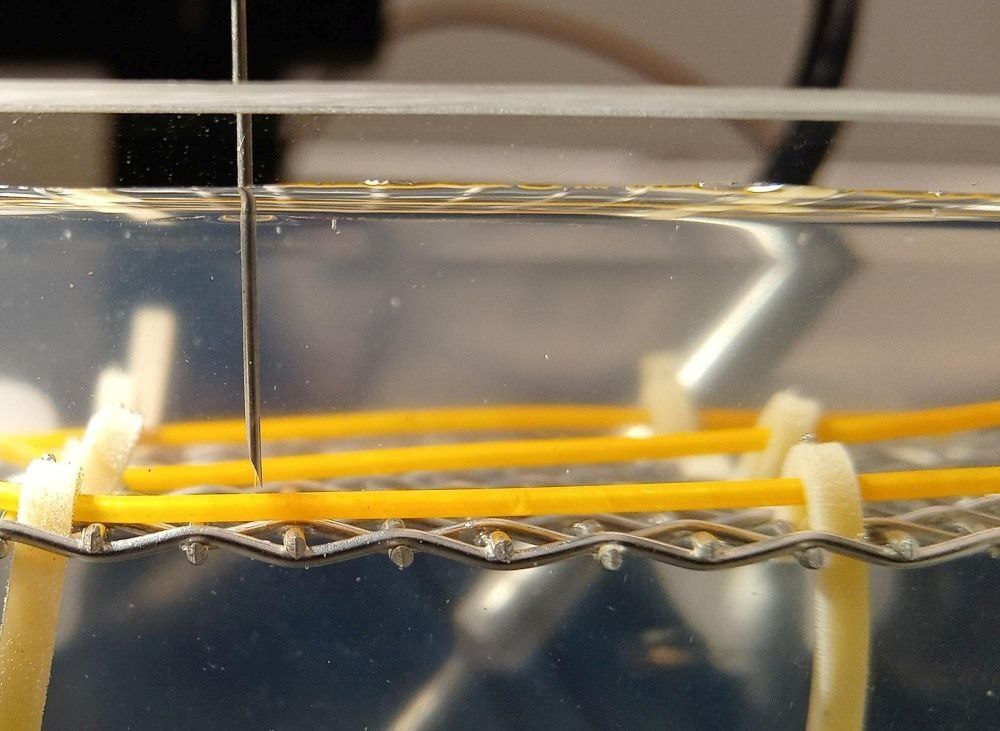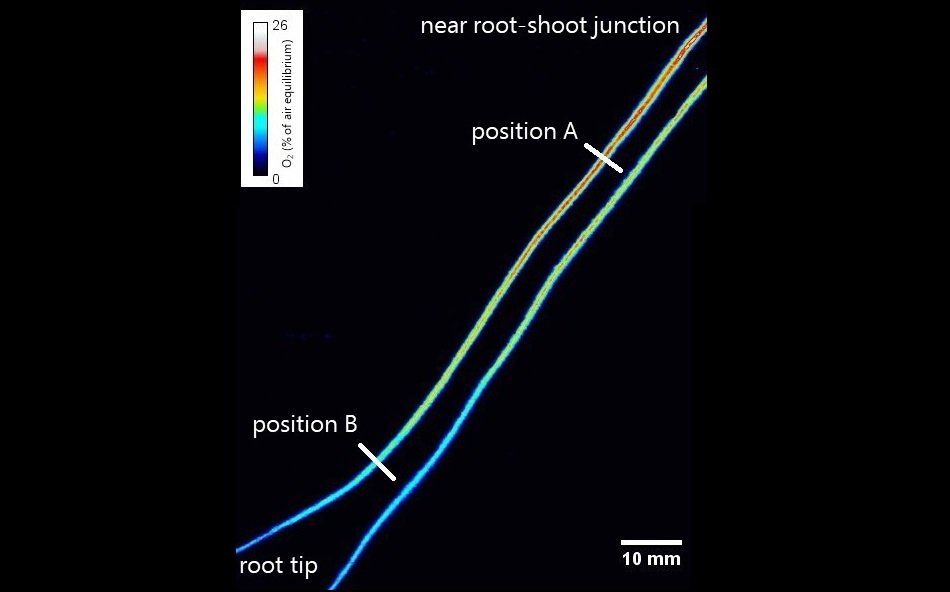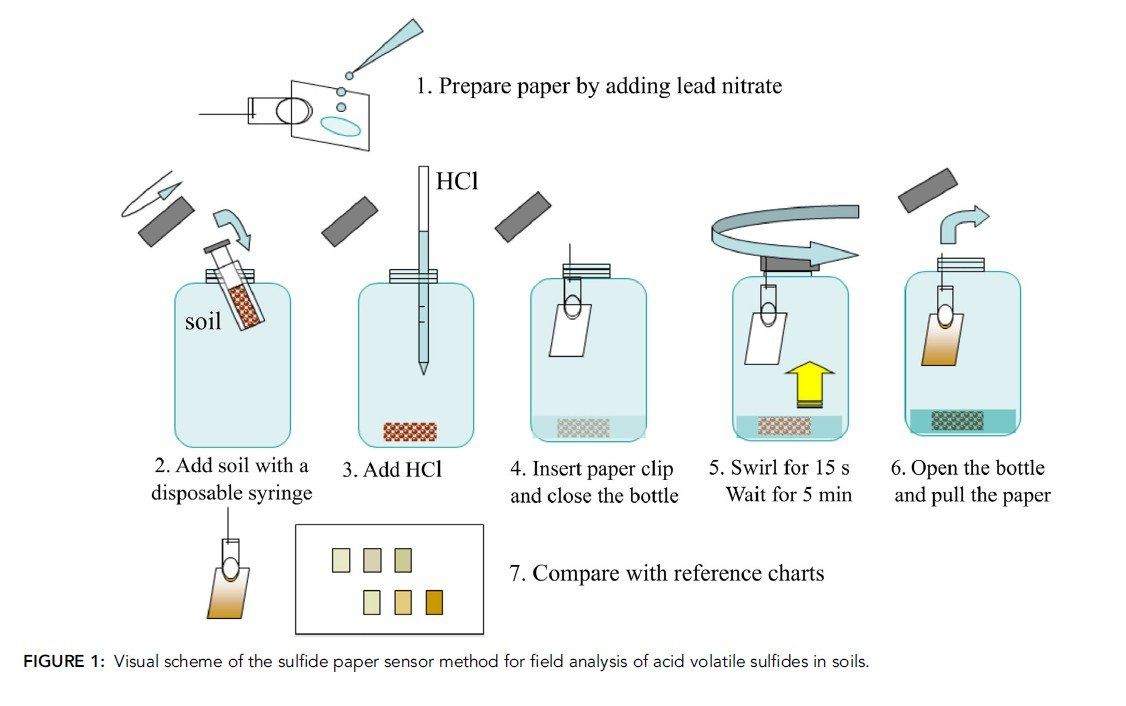Selected techniques based on research topics
-
Flooding stress
Flooding research deals with anoxic soils and flood-tolerant plant species. Gas exchanges are very slow in water compared to air, e.g. 10,000 times slower for oxygen. Acclimated plants are able to increase tissue oxygen levels and adapt to flooding (e.g. thicker roots with large aerenchyma). Oxygen can be measured inside plant tissues or at the root-soil interface.
Go to: Microsensors and optodes
Volatile phytotoxins are produced in anoxic soils by the microbial community. Soil sulfides are of main concern for plant survival, especially in soils flooded by seawater. Being easily lost by volatilisation, the accurate detection of sulfides can be challenging.
-
Soil biological activity
A soil can be characterised by its chemico-physical properties or based on its biological activity. The microbial community is an important aspect of soil fertility and mediates plant response to soil features and abiotic stresses.
Go to: Soil ATP and microbial biomass
Soil organic matter is the main soil component supporting microbial activity. Some components of the organic matter provide carbon as a source for microorganism growth. Other components can modulate the redox processes, especially in anoxic soils, acting as electron shuttle.
-
Metal toxicity
Contaminated soils challenge soil microbial activity and the survival of wild plant species and crops. Toxicity effects depend on the specific contaminant. Concentration and chemical form of the metal/element determine its toxicity and potential translocation in plant tissues.
Among toxic elements, mercury is a relevant issue in some areas of our region (e.g. Isonzo river). Mercury is dangerous even at very low concentrations and it can easily accumulate (depending on the chemical form) in the fat of animals and humans.
Microsensors and optodes
High-power techniques to monitor oxygen, solutes and volatile toxins at high resolution
Microsensors are of high spatial resolution, fast response and not-destructive method. Oxygen, hydrogen and sulphides dynamics could be easily monitored in soil, water and inside plant tissues. Sensors are customize for specific purposes allowing to measure gas concentrations even inside a single cell. Microsensors can be used to monitor temporal and spatial gas dynamics in soils and at the root-soil interface. Oxygen can also be measured using
microoptodes, another approach based on luminescence quenching in presence of oxygen.
Planar optodes are a recent developed technique for imaging that allows spatial and temporal monitoring of gases and solutes. Commonly applied for sediments, it is widely applied in rhizosphere studies involving micro and macrofauna. Oxygen and pH are the most common variables measured. Specific application developments involved toxins (e.g. sulphides) and ions (e.g. reduced Fe, phosphate).
Methods for measuring Radial Oxygen Loss were recently summarised in a review paper - Jiménez et al. 2021

Microoptodes
Radial oxygen loss (ROL) measurements using an optode sensor with a 50 µm tip
Pulsante
Microoptode profiles
Measuring oxygen gradients within the diffusive boundary layer (DBL)
Pulsante
Planar optode application
ROL measured on artificial roots using a coated planar optode
Pulsante
Planar optode image
Oxygen gradients (%) along Puccinellia roots
Pulsante
SPS field method
The Sulfide Paper Sensor (SPS) is a semi-quantitative field method to measure soil sulfides. The method was developed at the ESF section of the University of Udine.
The SPS method is based on volatilisation of H2S from soil, after a treatement with concentrated HCl, followed by precipitation of sulfides as PbS on paper charts. The coulor was standardised in the lab using standard solutions and a color chart map is used in the filed for comparison. The method has the potential to be improved into smartphone applications, allowing fast mapping of wetland soils, wordlwide.
The method is described in Pellegrini et al. 2018

Soil ATP and microbial biomass
Microbial biomass C and N and soil ATP are useful proxies to assess soil microbial activity and estimate soil fertiliy
Microbial biomass C and N are well established methods to estimate the microbial component of a soil and to estimate soil fertility, which is usually related to the microbial biomass. Recently, we proposed an advanced approach of machine learning to assess the main soil parameters affecting soil microbial biomass, in order to estimate fertility in vineyard soils (paper Pellegrini et al. 2020).
Our lab has focused on soil ATP (Kuzyakov's portocol). The great advantage is the possibility to use a very small amount of soil to increase the spatial resolution of data collected. Moreover, soil ATP can support metagenomic analysis by quantifying the relative abundance of soil bacterial species. It is therefore a great tool supporting interdisciplinarity between soil pedologists and genetists.
Humic substances
A recalcitrant reactive fraction of soil organic matter
The increasing concentration of humic substances in freshwaters is expected to alter local biotic geochemical processes and interfere with soil-plant interactions. Nevertheless, humic substances can be advantageous in anoxic sediments, being able to interfere with redox processes acting as electron shuttels for microorganisms. This topic is still poorly studied and of high interest among researchers, due to the intensifying brownification of freshwaters in the northern hemisphere.
Our lab is one of the few in world where references of humic substances are prepared, certified by the IHSS (International Humic Substances Society). Prof. Maria De Nobili is a main expert with a long experience in the field. A nice Comment on the importance of humic substance at the foollowing link.
ICP-OES
To measure element and toxic metal concentrations in waters, soils, organic plant tissues and many other matrices.
Inductively Coupled Plasma Optical Emission spectroscopy (ICP-OES) is an analytical technique based on the fact that atoms and ions can absorb energy to move electrons from the ground state to an excited state. The ICP-OES relies on those excited atoms releasing energy at specific wavelengths that are different for each element. The detection limit can be less than
1 ppm. Prof. Marco Contin is our local expert with experience on metal toxicity. A nice paper is available at this
link.
AMA analyser
Advanced Mercury Analyzer (AMA) for liquid and soilid samples
Based on catalitic combustion, the mercury is retained in a gold trap and then measure based on atomic absorption spectroscopy. With a very low detection limit of less than 0.01 ng, mercury ca be measured directly on solid samples like soil or ground plant tissues.
The long term mercury contamination from the Idrija mine in Slovenia had affected the Isonzo river banks and the Grado lagoon. Moreover, tons of Hg derived from a chlor-alkali plant (now disused) through the Aussa–Corno river. Despite most of the Hg is not easily mobilised (depending on the chemical form), Hg content can be monitored in soil and in plants, especially in areas affected by flooding and seawater intrusion that can increase Hg mobility.
Other approaches and techniques
Plant Biology
-
Field activity
ButtonStudying plant acclimation to flooding and soil erosion
-
Flood simulation
ButtonTides and different flooding levels can be simulated artificially
-
Pycnometer method
ButtonMeasuring plant tissue density and porosity
-
Hydroponics
ButtonPlants of Hordeum marinum grown in hydroponic culture
-
Methylene blue
ButtonRadial oxygen loss in Littorella uniflora
-
Microresp setup
ButtonMeasuring oxygen consumption
-
Root-sleeving electrode
ButtonMeasuring ROL on a rice adventitious root
Leaf gas film
On rice (Oryza sativa) leaf
Soil Chemistry
-
Munsell color chart
ButtonSoil color description
-
Nitrates and phosphates
ButtonSkalar San++ auto analyser
-
CHNS and isotopes
ButtonFor liquid and solid samples
-
Pedological survey
ButtonSoil profile description in the field
-
CO2 and CH4
ButtonGas chromatography
-
Ferrozine method
ButtonFor Fe II and Fe III analysis
-
TOC
ButtonOrganic carbon in liquid samples
-
Iron plaques
ButtonOn artifical roots in presence of humic substances
Data analysis
Many tools are available for researchers to present and analyse data with effective and advanced approaches.
From image (ImageJ) to landscape analysis (QGIS), images can be analysed to obtain qualitative and quantitative data.
Advanced statistics are powerful tools in the scientific reaserch. New improved analyses can provide opportunities to test complex hypotheses. R is a free and widely used software that allows countless opportunities for data analysis.





















